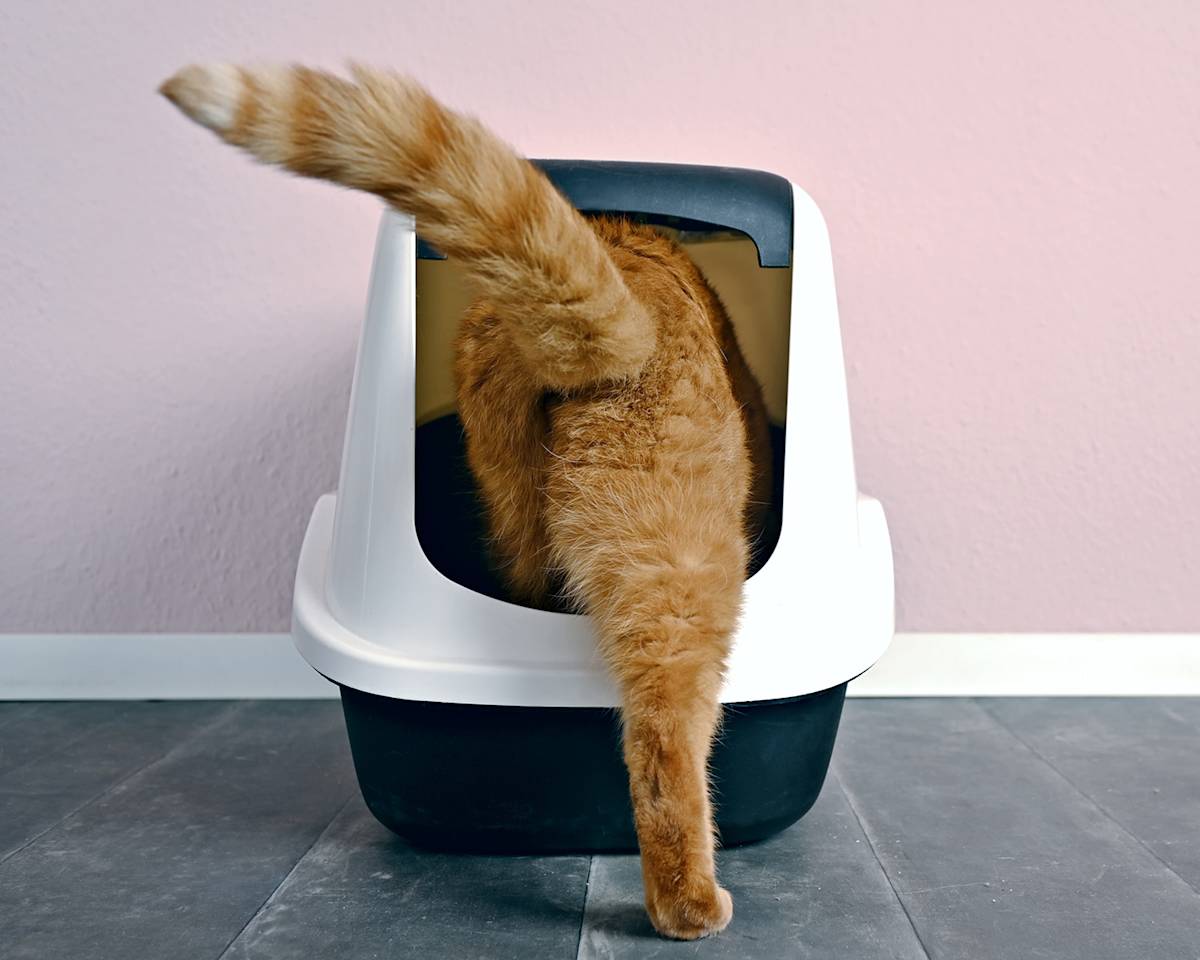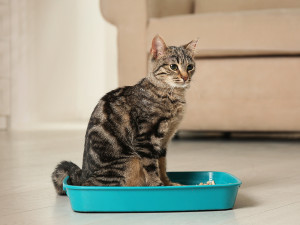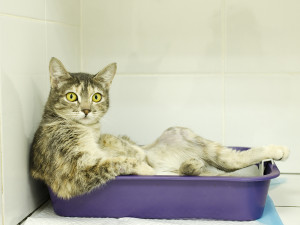What is Middening? Why Your Cat’s Pooing Habits Are Sending a Message
Get the scoop on this interesting cat behaviour

Share Article
OK, let’s talk about a topic nobody really wants to discuss but every cat parent needs to know about – middening. Have you ever walked into a room and found an unexpected pile of cat poo in the middle of the floor or deposited on the windowsill? It’s gross, frustrating, confusing, and if it’s happening in your house, you’re probably wondering if it’s a dirty protest, a medical issue, or some kind of weird power move. Here’s what you need to know.
What is ‘middening’?
Poo can end up on the floor if a cat hangs their butt over the edge of the litter box while they’re going to the toilet because the box is too small or they feel vulnerable and are rushing. It can also get kicked out if the box hasn’t been scooped enough, or your cat is a vigorous digger when they cover their poo.
Some cats develop a preference for a specific location outside the litter box if they’ve had a negative experience while using it. Others poo outside the box because they dislike the type or depth of the litter, the style of litter box, or if the cleanliness isn’t up to scratch.
Middening is a type of house soiling, but it differs from other forms of defecation outside the litter box due to its function. The least common type of house soiling, it involves a cat very intentionally pooing outside the litter box – usually in a visible spot in an open, high-traffic space, without any attempt to cover it up. Think by the patio doors, next to the cat flap, in the middle of the hallway, or in front of your closed-overnight bedroom door. And yes, we said intentionally. This isn’t your cat getting confused or having an accident. Middening is different from your typical litter box oopsie.
Why do cats midden?
Medical reasons
Conditions like feline idiopathic cystitisopens in new tab, constipation, diarrhoea or osteoarthritis can cause a cat to avoid the litter box due to experiencing pain or discomfort during defecation, or having difficulty accessing the box. Cognitive dysfunction syndrome (also known as feline dementia) can cause senior cats to forget the location of their litter box and poo on the floor. It’s not always accurate to label this as ‘middening behaviour’, as medical issues often lead to unintentional elimination outside of the litter box due to pain or impaired mobility, whereas true middening is a deliberate behaviour.
Behavioural reasons
Assuming the vet gives your cat a clean bill of health, it’s time to take a look at their physical and social environment. The main reasons for middening are:
Territorial stress, such as urine spraying. Middening is a form of olfactory and visual communication and is most often triggered by the presence of other cats. If your cat feels like their core territory is under threat by a new cat, dog, baby or even because a second-hand sofa that, unbeknownst to you, smells like someone else’s pet – they may resort to pooing in the open as a way to mark their territory. It’s their not-so-subtle way of saying ‘This is mine’.
Inter-cat tension. If you have more than one cat and they’re not vibing, one may midden to mark their territory or express anxiety related to social tension and perceived or actual competition for key resources within the home.
Anxiety – cats hate change. Moving house, new roommates, schedule shifts – they can all make your cat feel insecure about their access to resources or social interactions, which can lead to middening. In rare cases, separation anxiety can cause a cat to poo by a door if they’ve been denied access or in a location where their pet parent’s scent is strong, like their bed or a pile of dirty laundry, in an attempt to maintain a connection, self-soothe and feel more secure.
How to tackle middening behaviour
Once you’ve ruled out medical causes, you can start solving the mystery. And yes, it will take some detective work. Here’s where to start:
Location, location, location
Where your cat is middening gives you clues. Have they pooed on the sofa in your new glass conservatory or near a window? Perhaps they’ve deposited a pile next to the catio fence. Poo placement matters, as it can indicate where a perceived threat was or still is. Middening in these locations is likely occurring because free-roaming neighbourhood cats are staring into the house or patrolling the perimeter of the catio, intimidating your cat, who has resorted to using faeces to try to repel the intruder.
Apply stick-on frosted window film to the bottom of windows and glass doors to create a visual barrier. If you have a catio, use garden privacy screening to prevent your cat from seeing neighbourhood cats in the garden. And make sure that all key resources – litter trays, food, water and resting places – are located in private locations well away from windows and doors, so your cat can’t be overlooked by other cats stealthily peeking in.
Clean like a crime scene technician
You have to eliminate all traces of the scent. The scent of poo can linger on floors and soft furnishings and if your cat can smell it but the visual marker has disappeared, they may go back to the scene to leave a fresh pile. Use an enzymatic cleaner – not vinegar or bleach – to break down and completely eliminate the odour.
Enrichment and play
Stressed cats need outlets and distractions. Increased vertical space for climbing, jumping and perching, interactive play with wand toys, calming valerian toys for self-directed play, and puzzle feeders can all give cats a sense of control, release feel-good endorphins, and help reduce stress and anxiety.
When to call in the pros
If you’ve ruled out medical issues, optimised the litter box setup, made environmental changes, and the middening still continues, it’s time to get professional help. Ask your vet for a referral to a qualified clinical animal behaviourist, who will take a thorough history, undertake a stress review, diagnose the problem and create an individualised behaviour modification treatment plan. Pro tip – the earlier you call in a behaviourist, the easier it is to stop the middening before it becomes a habit.
Prevention tips
Cats thrive on predictability and control. Having a routine schedule for feeding, interactive play, grooming and sleep helps them to feel safe and secure.
Do you have a multi-cat household? Prioritise creating social harmony. Providing multiple resources – litter boxes, feeding stations, water stations, climbing trees, cosy beds, toys and food puzzles – is key. The general rule of thumb is one per cat, plus one extra, well-spaced apart and positioned throughout the house. This will ensure that all of your cats have choice and control, and prevent perceived or actual competition, which can cause tension and conflict.
Introduce any changes slowly. Whether it’s a house, a new pet, a new partner, a new sofa or a new routine, give your cat the time and space they need to adjust.
Think of the litter box as sacred ground – keep it clean, quiet and easy to access. Know your cat’s stress signs. Hiding, excessive vocalisation, over-grooming, aggression, toileting outside the litter box, and yes, middening, can all be red flags that they are experiencing fear, anxiety or frustration.
The bottom line: what is middening?
Middening is designed to make a statement, so usually occurs in obvious, open, high-traffic areas. It’s a form of scent-marking, similar to urine spraying, where the cat is trying to communicate its presence to other cats.
While it’s usually behavioural and related to territorial stress, it’s important to rule out underlying medical conditions that can cause or contribute to house soiling behaviour.
If it continues, call a clinical animal behaviourist. There’s no shame in needing help – cats are complex creatures. Prevention is all about consistency, cleanliness, and keeping your cat’s world predictable, safe and stress-free.
References
Ellis, Sarah L. H., et al. “AAFP and ISFM Feline Environmental Needs Guidelinesopens in new tab.” Journal of Feline Medicine and Surgery, vol. 15, no. 3, Feb. 2013, pp. 219–30.
Heath, S.E. (2007). Behaviour Problems And Welfareopens in new tab. In: Rochlitz, I. (eds) The Welfare Of Cats. Animal Welfare, vol 3. Springer, Dordrecht.
Learn, Amy and Horwitz, Debra. “Cat Inappropriate Elimination and its Interaction with Physical Disease.opens in new tab” Veterinary Clinics: Small Animal Practice, vol. 54, no. 1, Jan. 2024, pp. 121-134.

Claire Stares, BA (Hons), MA, PG Dip Clinical Animal Behaviour
Claire Stares is a feline behaviourist with a PG Diploma in Clinical Animal Behaviour from the University of Edinburgh Royal (Dick) School of Veterinary Studies. She’s dedicated to helping guardians and their cats overcome behavioural problems and thrive so that they can enjoy life together. A cat lady since babyhood (her first word was cat!), she has over 20 years of experience living and working with cats in homes, rescue environments and veterinary practices. A passionate advocate for training cats for enrichment and cooperative care, she practices what she preaches with her five cats: three rescued Domestic Shorthairs, Bimble, Bertie and Katie, a Siamese called Daisy Mae, and a Maine Coon named Horatio. When there isn’t a feline companion asleep on her laptop, she writes books and articles for various publications.
Related articles
![Cat sitting in a teal litter box]()
Mastering the Art of Litter Box Training: How to Train Cats to Use a Litter Box
If you do nothing else, teach your cat to poo in their litter box (and not in your shoe)
![Maine coon cat using the litter box.]()
Uncovered Secrets: Why Cats Don’t Always Cover Their Poo
And how you can encourage them to cover up after doing their business
![Cat sitting by its litter box]()
Is Your Cat Full of Sh*t?
Seriously, though – here’s how to deal with cat constipation
![cat sitting in a litter box]()
How to Deal with Cat Diarrhoea
Dr Audrey K Cook’s tips to getting to the bottom of a sh*tty situation




